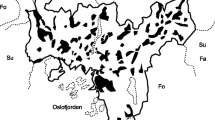Abstract
The application of Burnaby's similarity index is discussed by using structural data from mediterranean vegetation. The index, suggested to compare objects described by characters measured on different scales (mixed data), was applied in a fuzzy theory context. Ordinations of vegetation relevés and structural characters by joint plots have been obtained. These are very useful to map vegetation structural diversity in multidimensional spaces and to test the efficiency of an intuitive classification based on qualitative assessment.
Similar content being viewed by others
References
Anand, M. 1994. Pattern, process and mechanism. The fundamentals of scientific inquiry applied to vegetation science. Coenoses 9(2): 81–92.
Anand, M. & Orlóci, L. 1996. Complexity in Plant Communities: the Notion and Quantification. J. Theor. Biol. 179: 179–186.
Anderberg, M. R. 1973. Cluster analysis for applications. Academic Press. New York.
Arrigoni, P. V. 1996a. Documenti per la carta della vegetazione delle montagne calcaree della Sardegna centro-orientale. Parlatorea 1: 5–33.
Arrigoni, P. V. 1996b. A classification of plant growth forms applicable to the Floras and Vegetation types of Italy. Webbia 50(2): 193–203.
Barkman, J. J. 1979. The investigation of vegetation texture and structure. Pp. 123–160. In: M. J. A. Wreger (ed.), The Study of Vegetation. Junk, The Hague.
Barkman, J. J. 1988. New system of plant growth forms and phenological plant types. In: Werger, M. J. A. et al. (eds), Plant form and vegetation structure. SPB Acad. Publ. The Hague.
Burnaby, T. P. 1970. On a method for character weighting a similarity coefficient, employing the concept of information. J. Int. Ass. Math. Geol. 2: 25–38.
Dale, M. 1988. Mutational and Nonmutational similarity Measures: A Preliminary Examination. Coenoses 3: 121–133.
De Patta Pilar, V. & Orlóci, L. 1991. Fuzzy Components in Community Level Comparisons. Pp. 87–93. In: Feoli, E. & Orlóci, L. (eds), Computer Assisted Vegetation Analysis. Kluwer Academic Publishers, Dordrecht.
De Patta Pilar, V. & Orlóci, L. 1993. Character-based community analysis: the theory and an application program. SPB Academic Publishing bv.
Ezcurra, E. 1987. A comparison of reciprocal averaging and noncentred principal component analysis. Vegetatio 71: 41–47.
Feoli, E. 1977. On the resolving power of principal component analysis in plant community ordination. Vegetatio 33(2/3): 119–125.
Feoli, E. 1984. Some aspects of classification and ordination of vegetation data in perspective. Studia Geobot. 4: 7–21.
Feoli, E. & Lagonegro, M. 1979. Intersection analysis in phytosociology: computer program and application. Vegetatio 40: 55–59.
Feoli, E. & Lagonegro, M. 1983. A resemblance function based on probability: Applications to field and simulated data. Vegetatio 53: 3–9.
Feoli, E., Lagonegro, M. & Biondani, F. 1981. Strategies in syntaxonomy: A discussion of two classifications of grasslands of Friuli (Italy). Pp. 95–107. In: Dierske, H. (ed.), Syntaxonomy. Cramer, Vaduz.
Feoli, E., Orlóci, L., & Scimone, M. 1985. Measuring structural convergence of vegetation types on the basis of floristic data. Abstr. Bot. 9: 17–32.
Feoli, E. & Zuccarello, V. 1986. Ordination based on classification: yet another solution? Abstr. Bot. 10: 203–219.
Feoli, E. & Zuccarello, V. 1994. Naiveté of fuzzy system spaces in vegetation dynamics? Coenoses 9(1): 25–32.
Gower, J. C. 1970. A note on Burnaby's character-weighted similarity coefficient. J. Int. Ass. Math. Geol. 2: 39–45.
Gower, J. C. 1971. A general coefficient of similarity and some of its properties. Biometrics 27: 857–871.
Goodall, D. W. 1964. A probabilistic similarity index. Nature 203: 1098.
Goodall, D. W. 1966. A new similarity index based on probability. Biometrics 22: 882–907.
Goodall, D. W. 1993. Probabilistic indices for classification-Some extensions. Abstr. Bot. 17(1–2): 125–132.
Marsili Libelli, S. 1989. Fuzzy clustering of ecological data. Coenoses 2: 95–106.
Mueller Dombois, D. & Ellenberg, H. 1974. Aims and Methods of Vegetation Ecology. Wiley, New York.
Orlóci, L. 1978. Multivariate analysis in vegetation research. Junk, Den Haag.
Orlóci, L. & Orlóci, M. 1985. Comparison of communities without the use of the species: model and example. Ann. Bot. 43: 275–285.
Noy-Meir, I. 1973. Data transformation in ecological ordination. I. some advantages of non-centering. J. Ecol. 61: 329–341.
Podani, J. 1995. Multivariate data analysis in ecology and systematics. A methodological guide to the SYN-Tax 5.0 package. SPB Academic Publishing bv.
Roberts, D. W. 1986. Ordination on the basis of fuzzy set theory. Vegetatio 66: 123–131.
Sneath, P. H. A. & Sokal, R.R. 1973. Numerical taxonomy. W.H. Freeman and Company.
ter Braak, C. J. F. 1995. Ordination. Pp. 91–173. In: Jongman, R.F.G., C.J.F. ter Braak & O.F.R. Van Tongeren (eds), Data Analysis in Community and Landscape Ecology. Cambridge University Press, Cambridge.
Zhao, S.X. 1986. Discussion on Fuzzy Clustering. Pp. 612–614. 8thint. Conf. On Pattern Recognition, IEEE Press, New York.
Zimmermann, H.J. 1984. Fuzzy Set Theory - and its Applications. Kluwer-Nijhoff Publishing, Boston.
Rights and permissions
About this article
Cite this article
Carranza, L., Feoli, E. & Ganis, P. Analysis of vegetation structural diversity by Burnaby's similarity index. Plant Ecology 138, 77–87 (1998). https://doi.org/10.1023/A:1009760808505
Issue Date:
DOI: https://doi.org/10.1023/A:1009760808505




